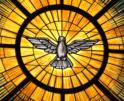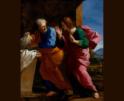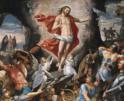
Faith
All of this underlines the "newness" of Easter. Especially, the newness of Christ's new life, which we share through baptism.

O'Grady
Celebrated as one Great Sunday of 50 days, Easter continues through Pentecost Sunday. Even the names of the Sundays of this season indicate this. The Sundays between Easter and Pentecost are called Sundays "of Easter," not "after Easter," as previously. The weekday Masses are similarly named, e.g., Thursday of the Fourth Week of Easter.
Following the Second Sunday of Easter, if there are solemnities, feasts, obligatory or optional memorials of the Lord, of the Blessed Virgin, or one of the saints, they can be celebrated. Ritual Masses (e.g., for confirmation, marriage, or holy orders); these Masses (the prayers texts and scriptural readings) may be celebrated on the Weekdays of Easter but not on Sundays.
The vesture of bishops, priests, and deacons will always be white or another festive color; usually, this means gold. The exceptions are on Pentecost (vigil and day) and observances of the holy martyrs when the proper color is red.
Advice for sacristans: this is the perfect time to clean and repair the green, violet, and rose vesture since they would not be used for these 50 days.
Until the final Mass of Pentecost Sunday, or until Evening Prayer II of Pentecost, whichever is the final public celebration, the Paschal Candle remains near the ambo, being lit for all liturgical celebrations. It should then be moved to a place near the baptismal font.
The Sunday readings will all be from the New Testament, the first from the Acts of the Apostles, and the second from one of the other New Testament Letters. According to the ancient custom of the church, preference for Gospel selections is given to the Gospel of John, both on Sundays and weekdays.
This ancient custom applies not only to Sundays and Weekdays but to every other liturgy during Easter. The Lectionary provides, for example, at marriages and funerals, a section of readings "First Reading during Easter."
In place of the Penitential Act, the Rite of Sprinkling could be used at Sunday Masses during Easter, emphasizing the relationship of this whole season to baptism, both of the newly and previously baptized. Some of the floral exuberance of Easter Sunday ought to be stretched through the season, both as a visual and sensory reminder of the 50 days.
All of this underlines the "newness" of Easter. Especially, the newness of Christ's new life, which we share through baptism.
Via Lucis
There are not many devotions associated with Easter; we probably have used a lot of the familiar ones during Lent. There is a relatively new one called the "Via Lucis" ("Way of Light"), which is a parallel to the "Via Crucis" ("Way of the Cross").
Matching the 14 Stations of the Cross, there are 14 Stations of Light. As with the Stations of the Cross, so the Stations of Light are quite biblical. Although they are still "in development," there seems to be a coalescing around these 14:
Jesus is raised from the dead -- Matthew 28:5b-6a
The finding of the empty tomb -- John 20:8
Mary Magdalene meets the risen Jesus -- John 20:14b-18
Jesus appears on the road to Emmaus -- Luke 24:15, 25-27
Jesus is known in the breaking of bread -- Luke 24:29-32
Jesus appears to the disciples in Jerusalem -- Luke 24:38-40
Jesus gives the disciples his peace -- John 20:19b, 20b-23
Jesus strengthens the faith of Thomas -- John 20:24-29
Jesus appears by the Sea of Tiberias -- John 21:10-12
Jesus forgives Peter and commands him to feed his sheep -- John 21:15,17b, 19b
Jesus commissions the disciples upon the mountain -- Matthew 28:19-20
The Ascension of Jesus -- Mark 16:19-20
Mary and the disciples wait in prayer -- Acts of the Apostles 1:13a, 14
The Holy Spirit descends at Pentecost -- Acts of the Apostles 2:2-4
There are not many places of worship that have "installed" these stations, but there are multiple ways that we can make the Easter journey with the early church on her way to being manifested to the nations at Pentecost.
Here are two:
From a notable Catholic News service: www.catholicnewsagency.com/resource/55486/via-lucis-way-of-the-light.
And another from our friends in the Diocese of Manchester, who have made readily available its version: ww.catholicnh.org/assets/Documents/Worship/Our-Faith/SOL-Prayer-Guide.pdf.
Regina Coeli
More widely known than the Stations of Light is the "Regina Coeli," an Easter hymn to the Blessed Virgin, chanted during the Easter Season in place of the Salve Regina.
Queen of Heaven, rejoice, alleluia.
For He whom you did merit to bear, alleluia.
Has risen, as he said, alleluia.
Pray for us to God, alleluia.
Rejoice and be glad, O Virgin Mary, alleluia.
For the Lord has truly risen, alleluia.
Let us pray. O God, who gave joy to the world through the resurrection of your Son, our Lord Jesus Christ, grant that through the intercession of the Blessed Virgin Mary, His Mother, we may obtain the joys of everlasting life. Through the same Christ our Lord. Amen.
Recent articles in the Faith & Family section
-
Through to PentecostFather Robert M. O'Grady
-
Behold the ManArchbishop Richard G. Henning
-
Living a Life of GratitudeMaureen Crowley Heil
-
New morningScott Hahn
-
Easter and its datingMsgr. Liam Bergin























